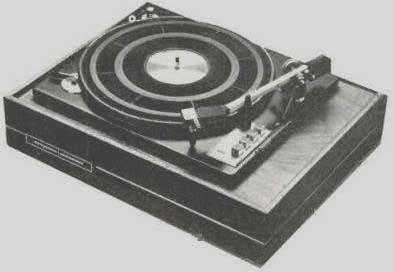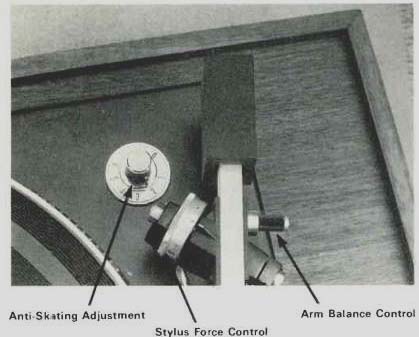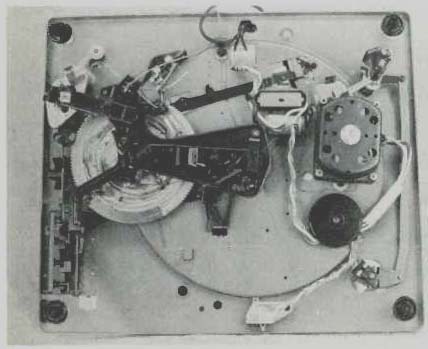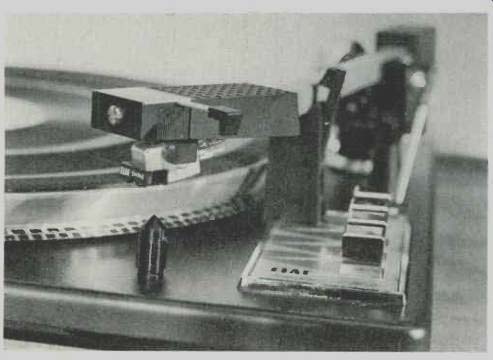
MANUFACTURER'S SPECIFICATIONS
Speeds: Three, 33 1/3, 45, 78 rpm. Platter Diameter: 12 in.
Wow: 0.06%. Flutter: 0.02%. Rumble (NAB):-40 dB. Arm Type: Balance and spring. Arm Resonance: Lower than 8 Hz. Maximum Stack of Records: 10. Height above motor board: 5% in. Clearance below motor board: 3 3/4 in.
Dimensions: (base) 18 1/2 W., 14 1/2 D.; overall, 10 in. H.
Weight: 18 lbs.
Price: $ 199.50.
The new Miracord 50 H-II follows in the tradition of the older 50H and incorporates a number of refinements which it […] an excellent instrument for the playing of records. […] itself measures 14 1/2 x 12 1/2, but to provide clear […] counterweight at the rear of the arm it requires a minimum of 16 1/2 inches in width if it is mounted in an existing space. The chassis rests on its base by means of four cone-shaped springs with plastic cups which fit into pre-drilled holes in the base. To dampen the springs against vibration, each is packed with foam rubber to cancel oscillations.
The rim of the platter is fitted with a plastic surround on which are the two stroboscope rings, illuminated from underneath the chassis by a neon lamp. The rim of the platter is chrome plated, and with the molded rubber mat and the highly polished center plate is most attractive. At the left front of the chassis is the three-position speed lever, and at the left rear is the vernier speed knob, calibrated in an equal number of divisions “+” and “-“ to provide a speed variation of +/-3 percent. A chart in the instruction book shows the relation between the migration time of one stroboscope line and the percentage of speed variation-if such precision is desired by the particular user. The speed variation is caused by the usual method of moving the idler up or down on the slightly tapered motor shaft, each of the three steps being tapered accordingly.
The "Magic Wand" changer spindle, first developed with the initial Miracord changers in 1952, provides the means of dropping records, with its three fingers retracting to drop the bottom record of the stack while an expanding portion holds the rest of the records stationary. This is a time-proven device and is much improved over the earlier design. For single-play use, a fixed spindle is provided, and to permit rotation of the record without friction against the body of the spindle, a sleeve turns freely around the device along with the record.
The counterbalance weight is fitted with a plastic extension which is molded with a rack along its underside to engage with a pinion actuated by the balance-adjusting knob, making the adjustment a simple act of turning the knob with the fingers. Stylus force is set by a large knurled knob calibrated in 1/4-gram divisions from 1/2 gram to 6 grams-in case anyone wants to install an early Capehart pickup. Anti-skating is controlled by a knob just behind the arm mounting. This knob is set to the number of corresponding to the stylus force. The arm itself is a 3/8-in. square aluminum tube which may be locked onto its plastic rest when not in use.
The cartridge retainer is integral with the arm, and the cartridge insert plugs into the retainer, making the required four connections. One unusual feature is the means for adjusting the "overhang" of the stylus. While most cartridge holders depend on the use of a plastic jig for mounting the cartridge in the exact location for minimum tracking error, the 50 H-II uses a screw adjustment accessible from the front to move the cartridge backward or forward to the correct position, which is indicated by a gauge mounted on the chassis. This gauge--a plastic molding with a conical point at the top--is raised to come close to the stylus, and the screw is adjusted to move the stylus exactly over the gauge. Simple and effective, and most convenient if you change cartridges often. After setting the stylus overhang properly, the gauge is pushed down and a stylus brush-furnished as a standard accessory-is slipped over the gauge and adjusted in height so the stylus just rests on the tip of the brush when at rest.
Among the other "plus" features in the 50 H-II is the use of a die-cast metal cam which performs all the necessary mechanical movements of the arm-raising it, moving it over the desired groove, where silicone piston gently lowers it to the surface of the record at the start of a play, and raising it, moving it over to the rest to permit the next record to drop at the end of a play. All this, in addition to operating the drop function of the "Magic Wand" changer spindle. Another interesting feature is the ability of the unit to play a single record continuously, and this action is instituted by placing the single-play spindle in the opening upside down. Then the record will play repeatedly as long as desired.
The actuating controls of the 50 H-II are contained in a chrome panel at the right front of the chassis. Here are four square pushbuttons-the front three are to start the play at diameters of 7 in., 10 in., and 12 in., respectively. The fourth button serves to stop the play, resulting in the arm being returned to the rest and the motor stopped. All four buttons operate with a feather touch--so gentle that actuating any one of them will not affect the playing of the record by the slightest degree. This is a particularly delightful feature with the low stylus forces used in playing LP records, especially with high quality cartridges.
The motor, which is a hysteresis/synchronous type, keeps speed as constant as the frequency of your power line, almost with no regard for the line voltage. We noted no change of speed at voltages as low as 85, while at 75 there was not enough power to go through a change cycle. Rarely are such variations noted in urban areas, although the voltage may drop during storms or "brownouts," though not likely as low as 75.
Similar constancy of speed was noted at line voltages as high as 135-also a rarity in the average home.

Fig. 1--Anti-skating control knob is located at the left of the arm mounting.
The knob is set to number corresponding to the stylus force being used.

Fig. 2--The underside of the chassis is as neat as the top. Note the use
of the die-cast metal operating arm.

Fig. 3--Gauge for setting "overhang" raises to the level of stylus,
while the screw on the front of the cartridge re loves the cartridge backward
or forward to center […] tip of the gauge.
Performance
We made the usual tests on the 50 H-II, using an Elac cartridge (as would be expected on an Elac-built Miracord) the top-of-the-line STS-444-E. Flutter (5 to 250 Hz) was measured at a minimal 0.03%, while wow (in the range from 0.5 to 6 Hz) was measured as 0.08%. Range of the vernier speed control was measured using a Heathkit IB-101 digital counter and playing a 1000-Hz tone. At the minimum + position, the frequency of the tone went up to 1031 Hz; at the maximum position, the indicated frequency was 968 Hz.
These figures show that the variation available ranged from +3.1% to-3.2%, or a total of 6.3%. The all-important rumble figure was measured with respect to a velocity of 3.54 cm/sec at 1000 Hz, which corresponds closely to the specified 1.0 cm/sec velocity at 100 Hz. The output of the cartridge was passed through an RIAA-equalized preamp, which in turn was followed by a 1500-Hz low-pass filter. Then the stylus played a "silent" groove on the CBS BTR-150 broadcast test record and the output noted. It was 41 dB below the 1000-Hz level, which is very good indeed, since it results in practical inaudibility of the rumble frequencies. The same BTR-150 record was also used for flutter and wow measurements-using for the wow figure the results obtained from several playings to make sure that the record was not eccentrically placed on the spindle.
With the test cartridge we also measured the tracking of high-level grooves. At a stylus force of 0.75 grams, the cartridge was able to track a 100-Hz groove on the CBS STR-100 record which has an amplitude of 0.005 in, corresponding to a stylus velocity of 3.14 cm/sec. (An amplitude of 0.001 cm is equivalent to a stylus velocity of 0.628 cm/sec at 100 Hz.) This indicates that the turntable, with the test cartridge, was easily capable of tracking practically any LP record, in which low frequency velocities should not exceed the test velocities.
Cycling time was a relatively slow 20 seconds, but when one considers the gentle handling of the records that is little enough price to pay for this sort of treatment.
Tracking error calculated close to the classic 0.5 deg. attained by the best offset-arm turntables. No arm resonance was noted down to 10 Hz, which was not unexpected considering the high compliance of the cartridge. On the whole, the 50 H-II Miracord is certainly the best of a long line of excellent automatic turntables, and should satisfy both the critical audio buff as completely as its appearance and ease of operation should please the distaff side of the household. The walnut base is an accessory item, as is the DCP-7 Operating Cover-a smoke plastic dust protector. The SSA-1 Power Control Adapter may be used in the base to turn off associated equipment with the last record on the stack is played-oftentimes a great convenience, especially if one likes to go to sleep to music.
-C.G. McProud
(Audio magazine, May 1972)
Also see:
Miracord/ELAC 50H turntable (Mar. 1970)
Miracord 760 turntable (ad, Jan. 1975)
B-I-C VENTURI speakers (Apr. 1974)
Garrard Zero 100 turntables (Jan. 1975)
= = = =